There were meetings in Ernakulam, Thrissur, and Thrippunithura in the 1920s demanding that Hindi be taught in schools. Three of the meetings were convened by women.
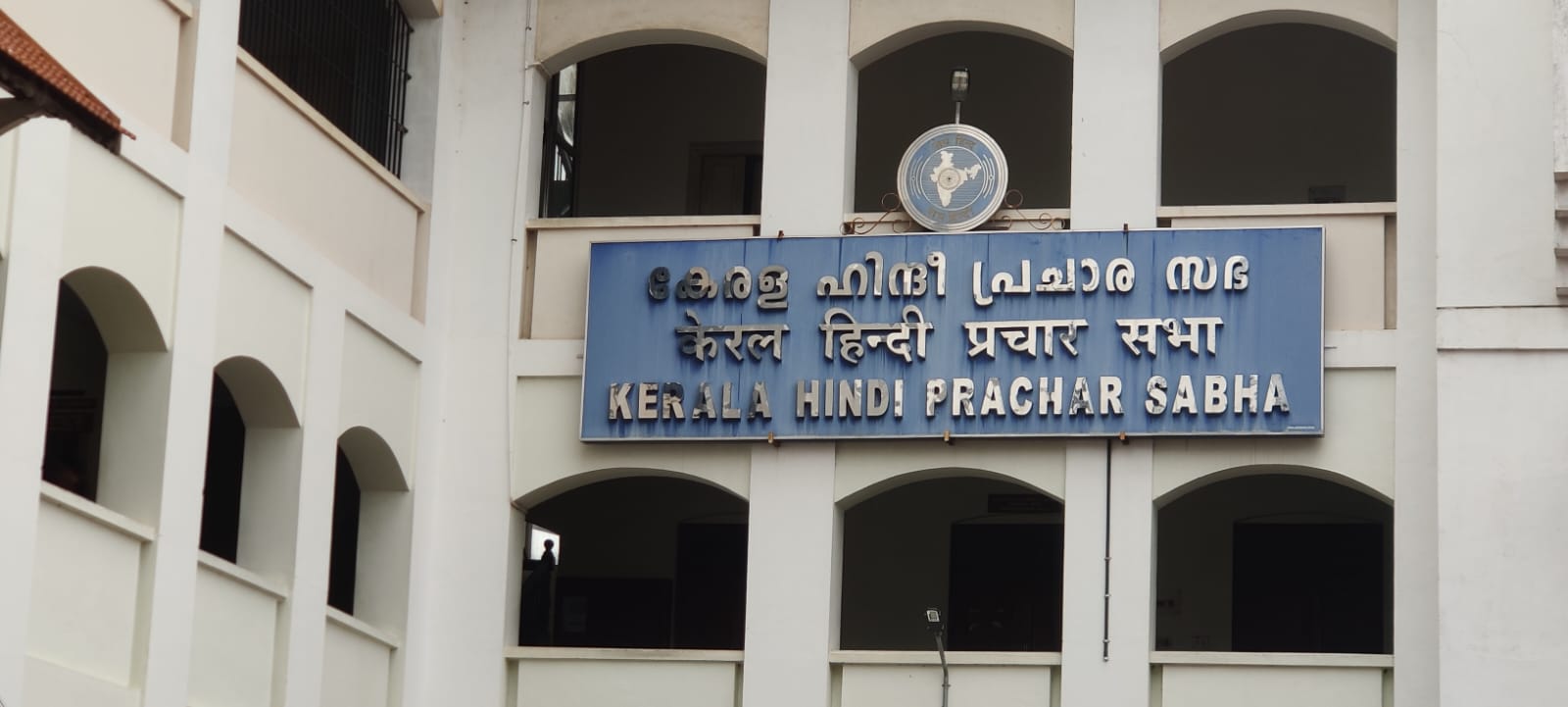
Kerala Hindi Prachar Sabha in Thiruvananthapuram (KB Jayachandran)
Can you imagine a time when a southern state considered Hindi the national language and vociferously demanded that it should be taught at educational institutions? Kerala has one such story to tell.
Kerala, a state that had once passed resolutions in favour of Hindi, is now among those raising their voices against the Union government’s attempt to impose the language.
It was that time when Kerala, as we call it today, was a collection of princely states and British-administered provinces. And the resolutions that recommended that the governments of the time teach Hindi as a compulsory subject in schools had come from the erstwhile princely states of Cochin and Travancore.
The first-such resolution was passed on 10 August 1928 by the erstwhile Cochin Legislative Council (CLC). Three years later, on the same day, the erstwhile Travancore Legislative Council (TLC) also passed a resolution.
The resolutions thus passed considered Hindi a language that could give “a spirit of unity” and “a spirit of nationality”.
The demand for Hindi learning had first come from the princely state of Cochin. There, representative public meetings were held demanding that the CLC pass a resolution.
There was also an instance when girl students of a high school signed a resolution in support of Hindi and demanded a teacher for the language.
Heeding the spirit of such demands, the CLC finally considered a resolution on 10 August 1928.
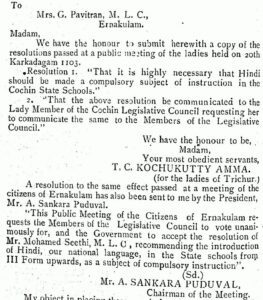
The resolutions that request the Cochin Legislative Council and the government to introduce Hindi as a compulsory subject in schools (Assembly Records)
It was Indian National Congress leader K Mohamed Seethi who moved the resolution: “This council recommends to the Government that the teaching of Hindi as a compulsory subject should be introduced in all the state schools at least from Form III upwards.”
Seethi Sahib, as he was known, brought to the notice of the council that four representative public meetings of the intelligentsia of the state (Cochin) have passed resolutions requesting the House to pass this resolution.
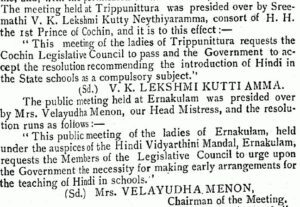
The resolutions that request the Cochin Legislative Council and the government to introduce Hindi as a compulsory subject in schools (Assembly Records)
While two meetings were convened in Ernakulam, one each was convened in Trichur (now Thrissur) and Trippunittura (now Thrippunithura). Interestingly out of four, three meetings were convened by women. He also added that the students of the Cranganur (now Kodungallur) Girls’ High School have signed their support of the resolution.
The one argument that dominated the discussion was if India were to choose a common language, then that should be Hindi.
Echoing the same, Seethi Sahib stated that if adopted as the common language, Hindi would knit together the people of this country.
“It (Hindi) is understood practically by the whole of India except the seven crores of South India. The acid test of any language should be ‘maximum benefit with minimum effort’. My respectful contention is that Hindi eminently satisfies the above test which no other vernacular can even think of,” said Sahib.
In her speech, the lone lady member who attended the discussion, Mrs G Pavitran, said that in supporting the proposal, she had the public opinion of the women of the state (Cochin) behind her as she cited the resolutions passed by women and girl students.
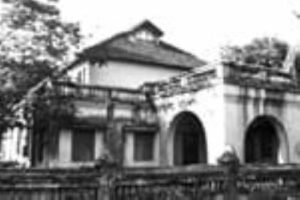
Government Law College, Ernakulam, where the
meetings of the Cochin Legislative Assembly were held (Kerala Assembly)
According to her, a common language was necessary for a nation, and Hindi was the only one that satisfied all the requirements of a national language.
She also made an interesting observation that Malayali students would find it particularly easy to study Hindi since it has a close kinship with it. To her, Hindi and Malayalam are sister tongues, both delivering their inspiration in grammar and construction from Sanskrit.
At the same time, the lone dissenting voice that came against the said resolution was from Rao Sahib C Matthai (member for education), who put forth the government’s view of the matter. He stated that though the government realised the importance of Hindi both from the cultural and utilitarian standpoints, if made a compulsory subject, it might add to the burden of the curriculum.
“Already there is a complaint that the curriculum of our secondary schools is overburdened,” he said then.
Twelve members participated in the discussion and finally, the resolution was placed and agreed to.
In the case of the resolution for making Hindi a compulsory subject in the schools of Travancore, what unfolded was a heated debate before it was agreed upon.
It was Damodaran Asan who moved the resolution at the TLC. According to him, as Hindi was most used by the people of India, it was the only tongue that could be adopted as a national language.
“Unless we adopt Hindi as our national language, we would not get a satisfactory and workable medium of communicating our thoughts to the other peoples of India with whom we are bound to come into contact soon. Hindi must be made a subject of study in our schools,” he said.
Like Mrs G Pavitran of CLC, Damodaran Asan believed that Hindi could be picked up with greater ease than English by the students as there is much that is common between Malayalam and Hindi. He mentioned the Sanskrit element in both.
Another member, K Kunjukrishna Pillai, wanted Hindi learning because “it would be a great solution to the problem of educated unemployment in Travancore”. To substantiate it, he cited that the industrial regions as well as the centres of business in the north need young men who had some knowledge of English and a working understanding of Hindi.
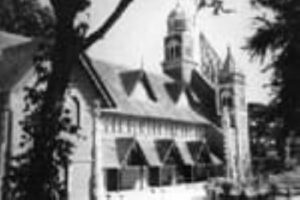
VJT Hall where the meetings of the Sri Mulam Popular Assembly, Travancore Legislative Council, Sri Mulam Assembly, and the Sri Chitra State Council were held (Kerala Assembly)
According to K Gopalakrishna Pillai, one of the dissenting voices against the resolution, for Travancore, three languages were necessary. For the purposes of the state, a man must know Malayalam; for taking part in Indian affairs, he must know the national language, which is Hindi; and for international purposes, he must know English too, was his argument.
He voted against the resolution because by restricting the teaching of Hindi to the higher classes, only a few students would be able to receive instruction in that language. He believed that a language is learned very easily when taught while the student is young and not when he is grown up.
Another prominent dissenting voice came from none other than Director of Public Instruction EG Mcalpine. According to him, the main arguments that were advanced in favour of the resolution were political. At one point, he even said there was no evidence that there was a demand (for Hindi learning) in Travancore. He was against the compulsory introduction of Hindi as he informed the House that in Mysore, Cochin, and Madras, Hindi was just an optional subject. He also cited the impracticality of introducing an extra subject (Hindi) due to the overloaded curriculum.
After a lengthy discussion, which saw 24 members airing their views, it was an amended resolution that was put to a voice vote in the House.
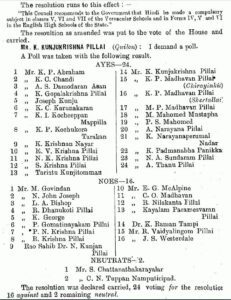
Details of the poll that took place at the Travancore Legislative Council on 10 August 1931 over the introduction of Hindi as a compulsory subject in schools (Assembly Records)
The resolution runs to this effect: “This Council recommends to the Government that Hindi be made a compulsory subject in classes V, VI, and VII of the vernacular schools and in Forum IV, V and VI in the English high schools of the state.”
Though the resolution was initially put to a voice vote and carried, one of the members K Kunjukrishna Pillai demanded a poll. While 24 agreed to the resolution, 16 disagreed, and two abstained.
According to historian and journalist Malayinkeezhu Gopalakrishnan, the time when the resolutions came is significant.
“The freedom struggle was gaining momentum at that time. For the nationalist leaders, Hindi was the only medium through which they could reach the people at the ground level,” Gopalakrishnan told South First.
The Simon Commission Protest and All Kerala Political Conference held at Payyannur in Kannur attended by Jawaharlal Nehru in 1928 might have influenced the first resolution. The Salt March and Civil Disobedience Movement (1930–31) might have influenced the second.
“Most probably the resolutions might have been implemented as they are not against the government,” added Gopalakrishnan.
According to writer and critic MN Karassery, Hindi was once limited to the courts of the princely states of Travancore and Cochin.
“There, a selected few were taught Hindi so that they could handle administrative and business affairs with their counterparts in the north. Among the people, the need to study Hindi came only when the struggle for independence reached a feverish pitch,” said Karassery to South First.
At the same time, linguist VR Prabodhachandran Nayar opined that compared to other southern states, Kerala was not averse to Hindi.
“There was a time when the people believed that Hindi learning was part of the freedom struggle. Thus, those who participated in the freedom movement and those who didn’t learn Hindi. The efforts of the Hindi Prachar Sabha in this is significant,” Prabodhachandran told South First.
Cut to 2022, Kerala believes that the Union government’s plan to impose Hindi is an onslaught on India’s cherished ideal of ‘unity in diversity.’
It also suspects that it is an affront to cooperative federalism. As said by chief minister Pinarayi Vijayan in a Facebook post, Hindi imposition is a “war cry” against the mother tongue of non-Hindi-speaking people.
(Dileep V Kumar has around seven years of experience as a reporter)

Jan 26, 2024

Dec 14, 2023

Oct 24, 2023

Sep 14, 2023

Aug 26, 2023

Jun 13, 2023